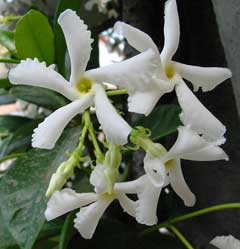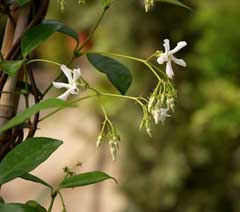 |
|
www.flickr.com/photos/globetrotter1937 |
 |
|
Translate this page:
Summary
Bloom Color: White, Yellow. Main Bloom Time: Early summer, Late summer, Mid summer. Form: Spreading or horizontal, Variable height, Variable spread.
Physical Characteristics

 Trachelospermum jasminoides is an evergreen Climber growing to 6 m (19ft) by 6 m (19ft) at a slow rate.
Trachelospermum jasminoides is an evergreen Climber growing to 6 m (19ft) by 6 m (19ft) at a slow rate.
See above for USDA hardiness. It is hardy to UK zone 9 and is frost tender. It is in leaf all year, in flower from July to August. The species is hermaphrodite (has both male and female organs).
Suitable for: light (sandy), medium (loamy) and heavy (clay) soils. Suitable pH: mildly acid, neutral and basic (mildly alkaline) soils. It can grow in semi-shade (light woodland) or no shade. It prefers moist soil.
UK Hardiness Map
US Hardiness Map
Synonyms
Rhynchospermum jasminoides.
Plant Habitats
Woodland Garden Sunny Edge; Dappled Shade; Shady Edge;
Edible Uses
References More on Edible Uses
Medicinal Uses
Plants For A Future can not take any responsibility for any adverse effects from the use of plants. Always seek advice from a professional before using a plant medicinally.
Anodyne Antibacterial Antirheumatic Antispasmodic Depurative Emmenagogue Febrifuge Restorative
Tonic Vasodilator
The leaf is restorative and tonic[178, 218]. This plant is especially useful for the aged[178]. The flowering stem is analgesic, antibacterial, antirheumatic, antispasmodic, depurative, emmenagogue, febrifuge, resolvent, tonic and vasodilator[176, 218]. A decoction is used in the treatment of rheumatoid arthritis, sore throats and various boils and abscesses[147, 176]. The seed is cardiotonic and haemostatic[218]. The whole plant is cooked with other foods and used to treat rheumatism[218].
References More on Medicinal Uses
The Bookshop: Edible Plant Books
Our Latest books on Perennial Plants For Food Forests and Permaculture Gardens in paperback or digital formats.

Edible Tropical Plants
Food Forest Plants for Hotter Conditions: 250+ Plants For Tropical Food Forests & Permaculture Gardens.
More

Edible Temperate Plants
Plants for Your Food Forest: 500 Plants for Temperate Food Forests & Permaculture Gardens.
More

More Books
PFAF have eight books available in paperback and digital formats. Browse the shop for more information.
Shop Now
Other Uses
References More on Other Uses
Cultivation details
Landscape Uses:Arbor, Container, Erosion control, Ground cover, Pest tolerant. Requires a well-drained moderately retentive soil in full sun or with part-day shade[200]. Requires a good humus-rich soil[11]. Succeeds in moderately acid or alkaline soils[202]. Requires the protection of a wall[11]. Plants are not very hardy outside the milder areas of Britain, tolerating temperatures down to about -5°c when grown against a wall[200]. They tolerate temperatures down to about -10°c according to other reports[202, 260]. Plants are slow-growing when they are young and they are then more susceptible to damage by frost and cold winds[11, 202]. They may put on no new growth for the first 2 - 3 years after planting out[202]. A twining plant[182]. Plants are self-clinging on walls according to other reports[166, 200]. Flowers are produced on short laterals that grow from old wood[200]. The flowers are deliciously scented[245]. Special Features:Attractive foliage, Not North American native, Naturalizing, Attracts butterflies, Fragrant flowers, Attractive flowers or blooms.
References Carbon Farming Information and Carbon Sequestration Information
Temperature Converter
Type a value in the Celsius field to convert the value to Fahrenheit:
Fahrenheit:
The PFAF Bookshop
Plants For A Future have a number of books available in paperback and digital form. Book titles include Edible Plants, Edible Perennials, Edible Trees,Edible Shrubs, Woodland Gardening, and Temperate Food Forest Plants. Our new book is Food Forest Plants For Hotter Conditions (Tropical and Sub-Tropical).
Shop Now
Plant Propagation
Seed - we have no information for this species but suggest sowing the seed in a greenhouse in early spring. When they are large enough to handle, prick the seedlings out into individual pots and grow them on in the greenhouse for at least their first winter. Plant them out into their permanent positions in late spring or early summer, after the last expected frosts. Cuttings of half-ripe wood, 6 - 8cm with a heel, August in a frame. Ensure that the milky sap, which is excreted from the heel when the cutting is taken, has dried out before the cutting is inserted in the soil. Fair to good percentage[78]. Layering in summer[188]. The plant self-layers, sending out roots from leaf nodes and stem tips wherever they touch the ground[245].
Other Names
If available other names are mentioned here
Native Range
TEMPERATE ASIA: China (Anhui Sheng, Fujian Sheng, Guangdong Sheng, Guangxi Zhuangzu Zizhiqu, Guizhou Sheng, Henan Sheng, Hunan Sheng, Jiangsu Sheng, Jiangxi Sheng, Shandong Sheng, Shanxi Sheng, Xizang Zizhiqu, Yunnan Sheng), Korea, Japan (Honshu (west), Kyushu, Shikoku), Taiwan TROPICAL ASIA: Vietnam
Weed Potential
Right plant wrong place. We are currently updating this section.
Please note that a plant may be invasive in one area but may not in your area so it's worth checking.
Conservation Status
IUCN Red List of Threatened Plants Status :

Growth: S = slow M = medium F = fast. Soil: L = light (sandy) M = medium H = heavy (clay). pH: A = acid N = neutral B = basic (alkaline). Shade: F = full shade S = semi-shade N = no shade. Moisture: D = dry M = Moist We = wet Wa = water.
Now available:
Food Forest Plants for Mediterranean Conditions
350+ Perennial Plants For Mediterranean and Drier Food Forests and Permaculture Gardens.
[Paperback and eBook]
This is the third in Plants For A Future's series of plant guides for food forests tailored to
specific climate zones. Following volumes on temperate and tropical ecosystems, this book focuses
on species suited to Mediterranean conditions—regions with hot, dry summers and cool, wet winters,
often facing the added challenge of climate change.
Read More
Expert comment
Author
(Lindl.)Lem.
Botanical References
1158200
Links / References
For a list of references used on this page please go here
Readers comment